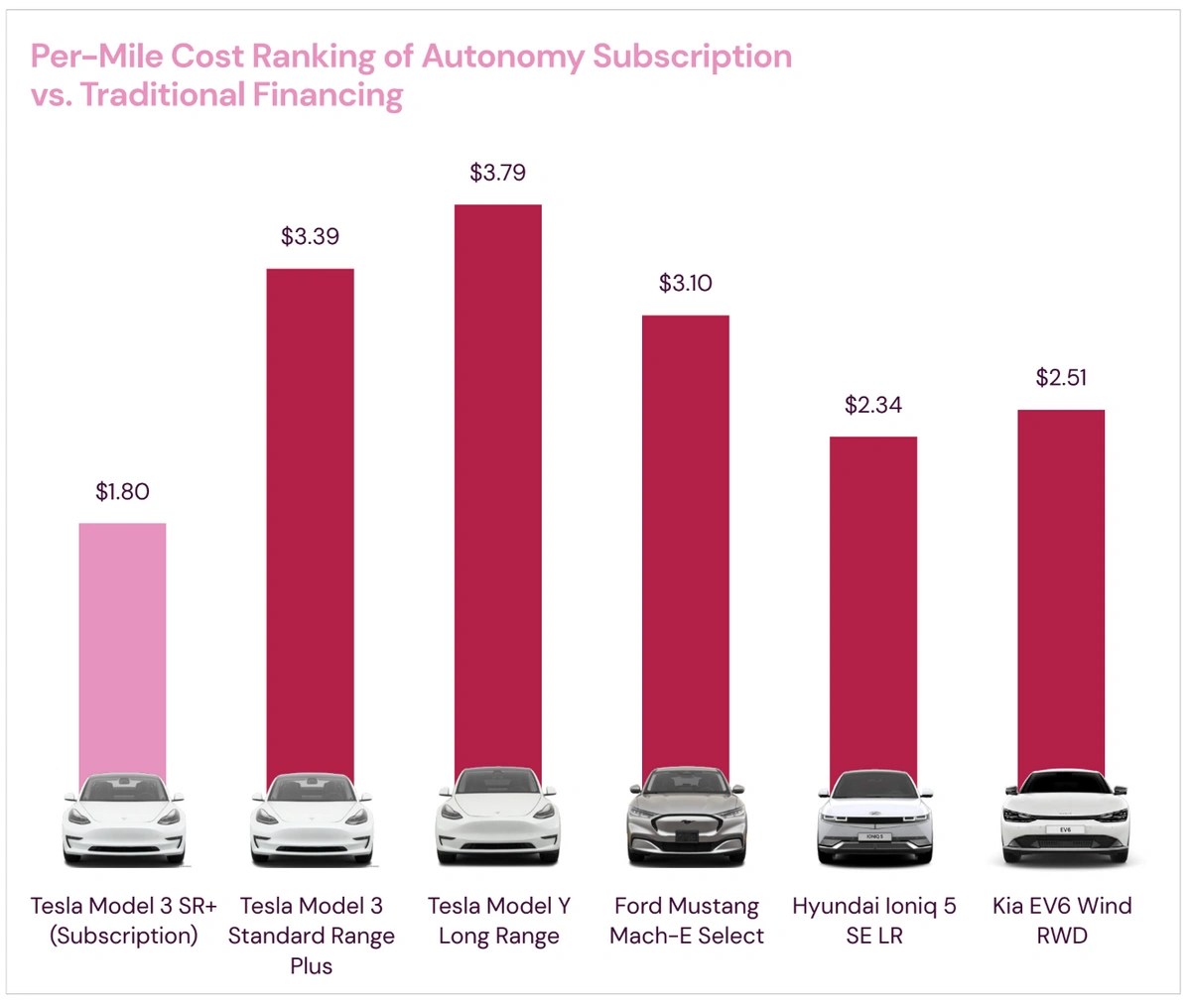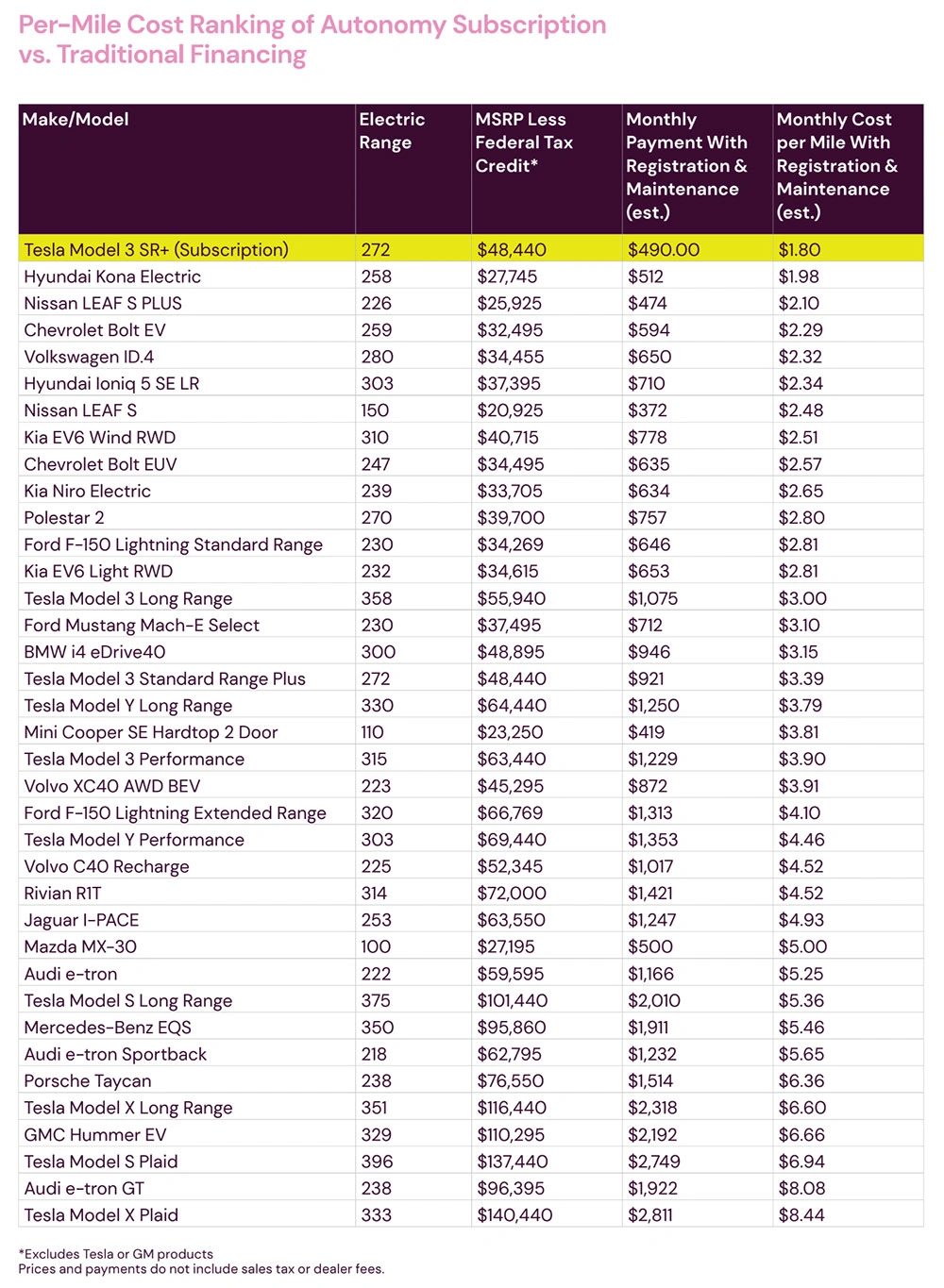Analyzing Electric Vehicle Subscription Models
December 20, 2022
Analyzing Electric Vehicle Subscription Models
Changing Consumer Patterns
Consumption patterns are visibly transforming from traditional ownership models to subscriptions, as evidenced by the hypergrowth of Netflix, Spotify, and other on-demand services.
The subscription economy empowers customers to control the duration and amount of their financial commitments. The “Spotify Generation” is moving away from ownership and prioritizing access and experience over material goods.
They’re accustomed to being able to engage and upgrade without the bother of being anchored down by something physical. Instead of buying CDs or DVDs, they stream music and movies from apps. They don’t read newspapers or magazines because they get their news online. They don’t print photos for albums; they use the cloud instead. They value the flexibility that comes with this digital lifestyle.
Growth of Vehicle Subscriptions
Consumers are increasingly more interested in customizable options that work best for them. Being flexible and giving customers options centered around product, delivery schedule, payment, and communication allow the best-performing brands to shift to a relational commerce model.
This is especially true of their relationship with the automobile. Rather than spending hours in a dealership negotiating to purchase or lease a vehicle and instead of committing a large amount of money for three to five years (or longer) and then being stuck with that vehicle for years, consumers who subscribe to vehicles are not carrying the responsibility of paying back an entire loan, nor are they obligated to a multiyear lease term. They are also able to obtain a vehicle while remaining free of the long-term worries of maintenance, depreciation, and lack of flexibility.
The subscription model is particularly significant for EV adoption, as it can serve as a pathway for EV-curious consumers to truly have an extended test drive to ensure the vehicle fits their lifestyle. Does it work with their daily commute? Where are they going to charge it? Is it suitable for their driving habits, including road trips? An EV subscription is an optimal way to test an EV without being committed to a sizable loan repayment or a long lease term.
The short-term aspect of the service is especially appealing, and in fact, some subscription plans, such as Autonomy, only require a three-month initial commitment, after which consumers can turn in their vehicle with 28 days’ notice.
Subscribers Go “All In”
In a subscription model, customers pay an “all-in” monthly fee that covers vehicle access, annual registration, and maintenance and servicing of the vehicle (and often, even roadside assistance). With EV subscription services, the increasingly expensive cost of gas is eliminated. Additionally, there are variations of this model, such as Audi’s shorter-term rental option, where customers pay a daily rate for vehicles. A range of OEMs have introduced subscription programs, which vary in terms of vehicle options, pricing, and term length.
Subscription models such as those offered by OEMs, including Care by Volvo, Nissan Switch, and Porsche Drive; rental car companies, including Hertz; and third- party EV subscription services, including Autonomy and Borrow, are expected to see increased consumer uptake over the next five years. This should attract a large range of players and introduce additional variability in offerings as those services adjust to evolving customer preferences.
Convenience
In a world where you can transfer funds, book a flight, and order groceries with the swipe of a finger, cars are finally catching up. Rather than requiring a lengthy visit to a dealership where a car shopper may spend hours negotiating a purchase or lease, subscription services such as Autonomy allow the consumer to skip loan approval altogether and complete the entire transaction in the comfort of their own home by using an app on their smartphone. Additionally, the current supply chain constraints are resulting in vehicle inventory shortages as well as selling prices that are routinely exceeding MSRPs. Rather than pay a premium or wait for months for an EV reservation, a subscriber may be able to obtain a vehicle much sooner when using the Autonomy platform.
Affordability
The EV revolution is in full swing and here to stay. OEMs around the globe are spending billions of dollars to be competitive in the new electrically charged automotive reality, while new brands are popping up on a consistent basis. Not all will survive.
On the other hand, full-scale consumer adoption of EVs will continue to be challenged by production constraints, inadequate charging infrastructure, battery range anxiety, and the “EV premium” caused by all of these factors.
Until this premium to buy EVs versus their internal combustion engine (ICE) counterparts truly disappears, which is likely to be many years from now, the electric vehicle industry needs creative solutions to widen the affordability to consumers while not creating additional debt burden or long-term commitments.
Electric vehicles do not always have an ICE vehicle equivalent for every model. Some models, like the Kona EV, are electric vehicles based on a substantially similar existing ICE vehicle, but most are not. Of the top 10 EVs (by sales in 2021), nine are on proprietary EV platforms not shared with any ICE model.
A Tesla Model 3, for example, falls within the entry-level luxury car segment and, as such, several competitors, including the BMW 3 Series, Audi A4, Acura TLX, and Volvo S60, may be considered as alternatives. At a base price of $48,440 for the Standard Range Plus, the Model 3 starts about 18% higher than those four models. In fact, of the top 10 EVs, nine have a higher starting price than similar ICE equivalents, the Nissan LEAF being the lone exception (thanks to a recent $4K+ price cut for model year 2022). On average, these top 10 cars are roughly 27% more expensive than their ICE counterparts, and that’s even after considering the federal tax credit of $7,500 that all EV models but the Tesla and General Motors vehicles are eligible for.
That 27% delta equates to just slightly higher than $200 a month more, over a 60-month finance term. Thus, there’s a need for more affordable options to drive an electric car. Leasing traditionally provided a relatively lower monthly payment alternative to financing. However, in the current market, with cars routinely selling at or even above their original MSRP, with little to no lease cash and a high money factor, the lease payment is oftentimes not substantially lower than the finance payment. Car rental or car sharing services are great short-term solutions if the end user needs the car for only a few days, but after that, those options become prohibitively expensive, costing as much as several thousand dollars per month.
Another option now available to consumers is a vehicle subscription. With a subscription, the end user does not purchase or lease the car from a dealership, nor do they borrow the car from a car rental agency. Instead, a third party acquires the vehicle and lets the end user drive that vehicle on a month-to-month basis. Because a subscription, such as the one offered by Autonomy, includes maintenance, repairs, and registration — items that can cost about 3% or more of the purchase price of the car every year — the savings can be more substantial than just the difference in monthly payment.
One method to assess the value of an electric car is how much you pay per month versus the range of the vehicle. Using a typical finance term of 60 months at an industry average interest rate of 4.09% with a $5,900 down payment, we calculated the monthly payment for each of the major electric cars available today, including an estimate for registration cost (including, in states such as California, an extra fee of $100–$175 on new electric cars to compensate for gas taxes the state misses out on). Monthly payments ranged from a low of about $372 for a base model LEAF S to well over $1,000 for many of the higher-end Tesla, Porsche, Audi, and Jaguar EVs. On this scale, the Autonomy Tesla Model 3 Standard Range Plus offering, at $490 a month with a $5,900 start payment, ranks the fourth-lowest monthly payment behind just the Nissan LEAF S, the Mini Cooper SE, and the Nissan LEAF Plus. However, when we assess the monthly payment per mile of EV range, the Autonomy Model 3 offering comes in as the least expensive, at $1.80 per mile of electric range. The next lowest cost per mile is the Hyundai Kona Electric (258 miles of range, about $512 per month), at $1.98 per mile of electric range, about 10% higher.
Monthly cost is not the only advantage with a subscription model. A subscription not only isolates the end user from value fluctuations, avoiding any potential negative equity, but it is also flexible, typically with only a month-to-month commitment. Subscriptions offer the most flexibility, especially when compared against the typical auto loan term of five to seven years or the 36-month contracts required with leasing. This is a substantial advantage for anyone new to electric vehicles who is looking to determine whether it fits their lifestyle, or anyone unsure of their vehicle needs a year or more into the future.
Furthermore, subscription payments are not considered debt obligations, hence they do not negatively impact debt-to-income ratio. Anyone who has applied for a mortgage can attest to the advantages of carrying a lower level of debt. Additionally, since the monthly subscription payments can be made with a credit card, consumers can enjoy the benefit of bonus rewards points generated. Therefore, anyone interested in electric vehicles but unsure where to start or concerned about the higher acquisition costs otherwise, can consider a subscription service as a viable option.
Environmental Benefits
More EVs on the road means cleaner air and fewer CO2 emissions for everyone. As the electric vehicle marketplace expands to offer a broader range of models, eco-conscious consumers will have a greater selection from which to choose. Switching to an EV subscription service gives consumers an easy way to drive affordably while going green.
Image by aleksandarlittlewolf on Freepik
•This article was excerpted from Autonomy’s Electric Vehicle Market Report, Issue 1. To download the full report for free, click here.

